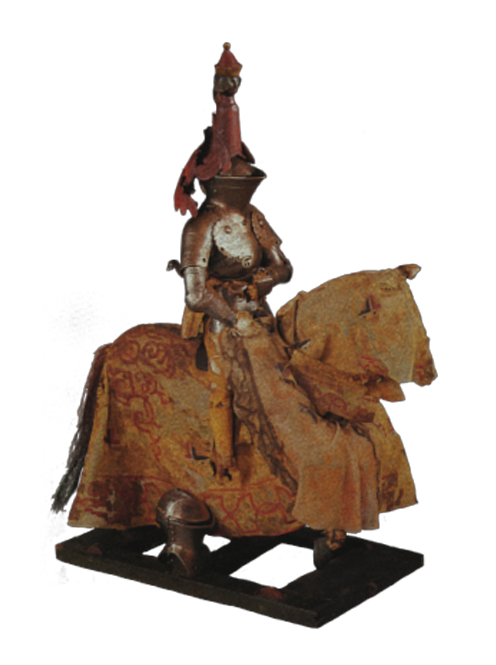Object Descriptions Tower House Bedroom
Toy knight
Spenser had at least three children, two boys and a girl (see Tower House Bedroom: crib and fireplace). His second son, Peregrine, was born to Spenser’s second wife, Elizabeth Boyle, whom he married in 1594. Presuming that Peregrine was born in wedlock, he would have been between 1-4 years old during the time portrayed in this hypothetical castle recreation (c. 1597-98). Like all children he must have had some toys, including hand-me-downs from his older brother Sylvanus.
This toy knight is dressed for a tournament and is modeled after one made in Nuremburg, c. 1530, and now in the Bayerisches Nationalmuseum in Germany. It shows great care in craftsmanship (with some sharp edges).
Literary Connections
Spenser’s work focuses frequently on marriage and childbirth but not often on childhood. He was no Wordsworth. We should keep in mind, however, that for all its political, ethical and moral significance, The Faerie Queene is a long Arthurian romance about knights, ladies, magicians and monsters. It was written to entertain and not only to instruct. Like its predecessors in the romance tradition, such as Ariosto’s Orlando Furioso (translated into English in 1591), parts of its action are fabulous, even ridiculous. Like this toy, the poem would have appealed to both children and adults on different levels.
A curious moment occurs in Book I of The Faerie Queene when a child frightens his mother by wanting to play with the talons (“talants”) of a dead dragon:

One mother, whenas her foolehardy chyld
Did come too neare, and with his talants play
Halfe dead through feare, her little babe reuyld,
And to her gossibs gan in counsell say;
How can I tell, but that his talants may
Yet scratch my sonne, or rend his tender hand. (FQ I.xii.11.1-6)
It is as if Spenser, with this word of caution, is breaking a fantastical spell that holds many a reader spellbound, like the child, throughout the dragon fight in the previous canto. The dragon is real, and the beast might still be dangerous. Likewise, Satan, or sin, might easily revive and will not be extinguished from the world until the end of time. Many threats will continue to plague the heroes in the poem.
Bibliography:
Pia Maria Grüber (ed.), “Kurzweil viel ohn’ Mass und Ziel”: Alltag und Festtag auf den Ausburger Monatsbildern der Renaissance (Munich: Hirmer Verlag, 1994): 36, 38.
Andrew Hadfield, Edmund Spenser: A Life (Oxford: Oxford UP, 2012): 326.
Brenda M. Hosington and Anne Shaver, “The Faerie Queene, children’s versions.“ Spenser Encyclopedia. Ed. A.C. Hamilton (Toronto: Toronto UP, 1990), 289-91.
Matthew Woodcock, “The Place of Arthur in Children’s Versions of The Faerie Queene.“ Arthuriana 13.2 (Summer 2003), 23-37.